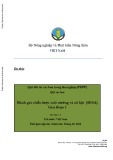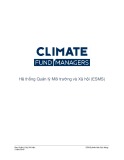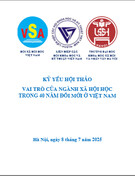
ISSN 1859-1531 - THE UNIVERSITY OF DANANG - JOURNAL OF SCIENCE AND TECHNOLOGY, VOL. 22, NO. 11C, 2024 57
GREENWASHING AND THE CHALLENGE OF SUSTAINABLE DEVELOPMENT
IN THE CONSTRUCTION INDUSTRY
Pham Ngoc Thinh*
Thuyloi university, Hanoi, Vietnam
*Corresponding author: thinhtls@tlu.edu.vn
(Received: September 14, 2024; Revised: September 24, 2024; Accepted: October 15, 2024)
DOI: 10.31130/ud-jst.2024.557E
Abstract - Greenwashing, defined as the dissemination of
inaccurate or misleading information regarding the
environmental performance of products, services, or brands, has
become increasingly prevalent in the construction industry. This
study examines the extent and consequences of greenwashing in
the sector, focusing on how exaggerated sustainability claims
influence stakeholder trust and decision-making. Employing a
mixed-methods approach - incorporating content analysis of
corporate sustainability reports and surveys of industry experts -
the research identifies common greenwashing strategies and
evaluates their effects. Findings reveal that overstated
environmental claims are pervasive, contributing to a significant
decline in stakeholder trust. The discussion addresses the ethical
implications of greenwashing, the challenges associated with its
detection, and offers solutions to enhance transparency and
accountability. This study advances the understanding of
greenwashing within the construction industry and provides
actionable recommendations to mitigate its negative impact on
sustainability initiatives.
Key words - Greenwashing; Construction Industry;
Sustainability; Stakeholder Trust; Environmental Responsibility
1. Introduction
As environmental concerns intensify and the global
movement toward sustainability accelerates, businesses
have increasingly sought to demonstrate their commitment
to eco-friendly practices. However, not all claims of
sustainability are authentic. Greenwashing, a term
introduced by environmentalist Jay Westerveld in 1986,
refers to the practice of deceiving consumers by
exaggerating or misrepresenting a company’s
environmental actions or the ecological benefits of its
products or services [1]. In 1986, Jay Westerveld coined
the term “greenwashing” after observing misleading
environmental claims during a stay at a hotel in the
Republic of Fiji. The hotel encouraged guests to reuse
towels “for the good of the planet”, when in reality, the
initiative was primarily aimed at reducing laundry costs.
Since then, the practice of greenwashing has become
increasingly widespread. In the 1980s, multinational
energy corporation Chevron launched a high-profile
campaign promoting wildlife conservation, all while
continuing to contribute to oil spills and environmental
degradation. Similarly, by the 2000s, British oil company
BP popularized the concept of “carbon footprint”,
introducing a formula for individuals to calculate their
carbon emissions. However, this was a strategic distraction
from BP’s significant contribution to global greenhouse
gas emissions, positioning the company among the largest
polluters worldwide.
Greenwashing is not confined to multinational
corporations; local businesses have also been criticized for
such practices. In Vietnam in 2019, the popular milk tea
brand PL faced public backlash for its lack of transparency
in environmental campaigns. While the store encouraged
waste sorting with labeled bins, it was later revealed that
all the waste was disposed of in a single plastic bag. The
company further alienated customers by imposing
additional charges for plastic cups, inadvertently
increasing plastic waste. Similarly, the HL coffee chain
launched a “green” program aimed at reducing plastic
waste, yet continued to serve customers in plastic cups,
even for in-store orders.
The real estate sector has also fallen prey to
greenwashing. Developers frequently market projects
using terms such as “green”, “nature”, and “ecological”,
featuring lush imagery of green spaces and
environmentally friendly designs. However, the reality of
these developments often falls short of their advertising
promises, highlighting a significant gap between marketing
rhetoric and actual environmental impact. As consumer
awareness of environmental issues continues to rise, so too
has the sophistication of greenwashing tactics, making it an
increasingly pervasive problem across industries [2].
Figure 1. Total number of alleged cases of deceptive media [3]
2. Data and Research Methodology
Data collection for this study focused on academic
journals, industry reports, and legal documents related to
greenwashing and corporate sustainability practices.
Databases such as ScienceDirect, JSTOR, and Google
Scholar were utilized with search terms including
“greenwashing”, “corporate social responsibility”,
“sustainability marketing”, and “environmental
deception”. Corporate communications, such as annual
reports, marketing materials, and sustainability reports
from 20 major companies, were analyzed to identify
patterns and indicators of greenwashing [8].

58 Pham Ngoc Thinh
Additionally, the study incorporates data from a survey
of 500 consumers, designed to assess their perceptions of
corporate sustainability claims and their level of skepticism
toward green marketing strategies [9]. The survey
addressed topics including general awareness, trust,
purchasing behavior, and the ability to recognize
greenwashing tactics. Corporate documents and reports
were systematically coded and categorized to identify
greenwashing-related themes, such as the use of
ambiguous sustainability terminology, lack of
transparency, and questionable certifications. This analysis
revealed specific tactics employed by companies to present
a misleading image of environmental responsibility. The
survey results from both consumers and experts were
analyzed to evaluate the prevalence of greenwashing in
sustainability claims and to explore the relationship
between greenwashing and consumer skepticism.
3. Research results
3.1. Prevalence of Greenwashing
The analysis revealed that greenwashing is widespread
across various industries, with notable examples in the
automotive, food and beverage, energy, and fashion
sectors. In the automotive industry, many companies have
promoted “green electric vehicles” to attract
environmentally conscious consumers while continuing to
invest significantly in fossil fuel technologies. Several
major automakers have announced plans to expand electric
vehicle production, yet simultaneously maintain or
increase their production of gasoline and diesel vehicles.
This creates a stark contradiction between their green
marketing and their actual business practices [10].
Similarly, in the fashion industry, numerous brands
emphasize their use of environmentally friendly materials
to cultivate a sustainable image. However, many fail to
provide transparency regarding their supply chains,
making it difficult for consumers to verify these
sustainability claims [11]. This disconnect between
marketing messages and actual manufacturing practices
contributes to the increasing prevalence of greenwashing
within the industry.
The technology industry is not exempt from
greenwashing, as many companies promote their products as
energy-efficient while neglecting end-of-life recycling.
Several major electronics manufacturers claim to be
committed to reducing the energy consumption of their
devices, yet fail to establish effective take-back and
recycling programs for used products, thereby undermining
the credibility of their sustainability claims [12].
In the food and beverage industry, numerous
companies label their products as “organic” or “natural” to
appeal to health-conscious and environmentally aware
consumers. However, many of these products fail to meet
strict organic standards, leading to consumer confusion and
potentially misleading perceptions about the true
sustainability of the products [13].
The energy sector has also experienced widespread
greenwashing, with companies promoting a partial shift
to renewable energy while continuing to operate
extensive fossil fuel activities. Major oil and gas
companies, such as ExxonMobil and Shell, frequently
publicize renewable energy initiatives and carbon
reduction commitments to bolster their environmentally
friendly image. However, reports suggest that these
companies continue to invest heavily in oil and natural
gas exploration, undermining the credibility and
effectiveness of their sustainability pledges [14].
Table 1. Some legal actions
No
Industry
Violate
Legal action
1
Car
Misleading advertising
about electric vehicle
benefits
Fines for
misleading
statements [15]
2
Fashion
Using the “sustainable”
label without supply
chain transparency
Warning to
consumers [16 ]
3
Technology
Overhyped about energy
saving
No action yet
4
Food and
Beverage
Non-compliance with
organic certification
standards
Product recall
[17 ]
5
Energy
Partial transition to
renewable energy but
maintaining fossil fuel
investment
Conduct
investigation
[18]
Greenwashing has become a growing concern in the
global construction industry, with multiple studies
highlighting a substantial rise in false or misleading
sustainability claims. According to the Global Resilience
Initiative (GRI) 2022 report, approximately 70% of the
world’s leading construction companies used vague terms
such as “eco-friendly”, “green”, or “sustainable” in their
reports, often without offering detailed information or
supporting data.
Greenwashing is a global issue, but its prevalence
varies significantly across regions. According to a 2021
report by the United Nations Environment Programme
(UNEP), the European region exhibited the highest rate of
greenwashing, with approximately 75% of major
construction companies making questionable sustainability
claims. In comparison, Asia and North America reported
lower, yet still substantial, rates of 65% and 60%,
respectively.
Greenwashing is widespread not only among general
construction companies but has also permeated specific
sub-sectors such as building materials manufacturing,
waste management, and architectural design. A 2023 report
by the Construction Industry Institute (CII) revealed that
80% of companies in the building materials manufacturing
sector utilized unverified or exaggerated environmental
certifications related to recycling and carbon reduction
(CII, 2023).
Compared to other industries, such as energy or
manufacturing, the construction sector exhibits a higher
rate of greenwashing, largely due to the significant role and
complexity of environmental factors in the construction
process. Lyon and Montgomery noted that while the
energy industry reported approximately 50% of
greenwashing cases, the construction industry reached

ISSN 1859-1531 - THE UNIVERSITY OF DANANG - JOURNAL OF SCIENCE AND TECHNOLOGY, VOL. 22, NO. 11C, 2024 59
70%, highlighting the challenges of implementing
comprehensive sustainable practices in large and complex
projects [20].
3.2. Greenwashing tactics
Research has identified several common tactics
employed by businesses to greenwash their practices.
These include using vague or misleading terms such as
“eco-friendly”, “green”, or “natural” without providing
clear definitions or supporting evidence [19]; engaging in
selective disclosure by emphasizing minor sustainability
efforts while concealing significant environmental impacts
[20]; leveraging third-party certification through
unverified certifications or approvals to enhance the
credibility of their claims [21]; and utilizing green branding
and imagery by incorporating nature-related visuals and
green color schemes in marketing materials to project an
environmentally conscious image [22]. These tactics not
only undermine the legitimacy of sustainability claims but
also mislead consumers about the true scope of a
company’s environmental initiatives.
Figure 2. Common Greenwashing tactics
3.3. Impact on consumer behavior
Figure 3. Consumer perceptions of greenwashing
Survey results indicate that greenwashing has a
significant impact on consumer trust and purchasing
decisions. Specifically, 65% of respondents reported losing
trust in companies after discovering instances of
greenwashing [23]. Additionally, 45% of consumers
admitted to actively avoiding brands suspected of engaging
in greenwashing [24]. Skepticism toward sustainability
claims has also risen, with 70% of consumers expressing
uncertainty about the accuracy of such claims [25]. These
findings suggest a growing consumer awareness and
vigilance against deceptive marketing practices, which
directly influence purchasing behavior and brand loyalty.
3.4. Legal response
Research indicates that regulatory responses to
greenwashing vary significantly across regions and
industries. For instance, the European Union has
implemented strict regulations aimed at curbing
misleading environmental claims [26]. In contrast, in
regions with less stringent regulations, companies often
rely on voluntary initiatives and self-regulatory
certifications [27]. Additionally, the growing influence of
advocacy groups and consumer pressure has driven some
organizations to adopt more transparent sustainability
reporting practices [28]. These differences highlight the
diverse ways in which companies manage and respond to
environmental issues, which, in turn, impact their business
strategies and reputations across various markets
4. Discussion
4.1. Ethical issues of greenwashing
Greenwashing raises significant ethical concerns,
primarily revolving around deception and manipulation.
Companies that engage in greenwashing prioritize profit
over genuine environmental responsibility, misleading
stakeholders about their true sustainability performance.
This practice not only harms consumers but also
undermines legitimate sustainability efforts, eroding public
confidence in environmental initiatives.
4.2. Challenges in detecting greenwashing
Detecting greenwashing in the construction industry
presents several challenges. First, the ambiguity in
terminology is a major obstacle, as words like “green
building”, “energy efficiency”, and “sustainability” are
often used without standardized definitions, making it
difficult to assess the accuracy of environmental claims.
Second, the construction sector's complex supply chain,
involving multiple contractors and suppliers, complicates
efforts to track processes and assess environmental
impacts, facilitating greenwashing. Lastly, the absence of
coordinated sustainability standards leads to inconsistent
and unverifiable claims about sustainability performance,
further hindering the detection of greenwashing.
Overcoming these challenges requires collaborative efforts
from organizations, regulators, and researchers to develop
clear standards and effective tools for assessing
greenwashing.
4.3. Strategies to combat greenwashing
A multifaceted approach is essential to combat
greenwashing. First, legal enforcement must be
strengthened to ensure strict compliance and prevent
deceptive environmental practices. Second, certifications
from independent organizations like LEED (Leadership in
Energy and Environmental Design) and regular audits can
enhance transparency and the credibility of sustainability

60 Pham Ngoc Thinh
claims. Third, providing stakeholders with accurate
information on how to identify greenwashing enables
informed decision-making and places pressure on
companies to honor their sustainability commitments.
Corporate transparency is also crucial, encouraging
businesses to report their sustainability efforts in detail and
honestly, thereby promoting social responsibility and
building consumer trust. By sharing accurate and
comprehensive information, companies not only enhance
their reputations but also help consumers make responsible
choices. These strategies must be implemented in close
coordination among regulatory bodies, certification
organizations, businesses, and consumers to achieve
maximum effectiveness in curbing greenwashing.
4.4. Consequences for business practice
Businesses must recognize the long-term benefits of
genuine sustainability commitments compared to the short-
term gains of deceptive practices. Authentic corporate
social responsibility (CSR) initiatives enhance brand
reputation, strengthen customer loyalty, and promote
sustainable development. Investing in sustainable activities
benefits both the environment and the community, while
also creating long-term value for businesses by building a
trustworthy image and attracting socially responsible
consumers. Transparent sustainability efforts foster strong
consumer trust, providing a sustainable competitive
advantage. Conversely, engaging in greenwashing can
have severe consequences, including reputational damage,
legal liability, and loss of consumer trust, all of which can
negatively impact a company’s long-term development. A
damaged reputation can lead to reduced sales, strained
business relationships, and difficulties in establishing new
partnerships. Thus, maintaining authentic and sustainable
CSR is crucial for the long-term stability and growth of
businesses, enabling them to build a solid reputation and
contribute positively to both the community and the
environment.
4.5. Future research directions
Future research should focus on several key areas to
better understand and address the greenwashing
phenomenon, particularly in the construction industry.
First, impact assessments are needed to evaluate the long-
term effects of greenwashing on market dynamics and
global sustainability goals. These studies can clarify how
greenwashing influences consumer decisions, business
competition, and progress toward achieving sustainability
goals, providing a reliable basis for policy and regulatory
improvements. Second, developing technological solutions
is essential for detecting and monitoring greenwashing in
real time. Advanced tools such as big data analytics,
artificial intelligence (AI), and transparency monitoring
platforms can enable rapid identification of greenwashing
indicators, helping regulators and consumers make more
informed decisions. Finally, cross-cultural research should
explore how greenwashing manifests in different cultural
and legal contexts. Understanding these variations will aid
policymakers and international organizations in
developing region-specific strategies to effectively combat
greenwashing globally. These research directions will not
only contribute to the theoretical understanding of
greenwashing but also provide a practical foundation for
developing effective policies and tools to address it. The
integration of theory and practice will ensure the feasibility
and broad applicability of countermeasures across
industries and regions.
5. Conclusion
Greenwashing poses a significant challenge to
sustainability efforts in the construction industry,
particularly in Vietnam. This study has demonstrated that
inaccurate or misleading sustainability claims undermine
stakeholder trust and weaken legitimate environmental
protection initiatives. The content analysis of corporate
reports, combined with survey results, reveals the
widespread use of greenwashing tactics, including vague
claims, unreliable certifications, and a lack of supply chain
transparency. Consequently, stakeholder trust, especially
among consumers and investors, is eroding, which presents
a substantial barrier to achieving genuine sustainability.
To combat greenwashing effectively, it is crucial to
increase transparency, enforce third-party audits, and
establish strict legal regulations to prevent the
dissemination of inaccurate environmental claims within
the construction industry. These measures are essential to
restoring stakeholder confidence and ensuring that
sustainability efforts are both credible and impactful.
REFERENCES
[1] United Nations Environment Program, “2019 Global Status Report
for Buildings and Construction”, United Nations, New York, USA,
Report 2019, 2019.
[2] T. P. Lyon and A. W. Montgomery, “The means and ends of
greenwash”, Organization & Environment, vol. 28, no. 2, pp. 223–
249, 2015.
[3] European Banking Authority, “Greenwashing monitoring and
supervision”, European Banking Authority, Brussels, Belgium,
Report 2024, 2024.
[4] M. A. Delmas and V. C. Burbano, “The Drivers of Greenwashing”,
California Management Review, vol. 54, no. 1, pp. 64–87, 2011.
[5] C. Marquis and M. W. Toffel, “Scrutiny, Norms, and Selective
Disclosure: A Global Study of Greenwashing”, Organization
Science, vol. 23, no. 3, pp. 744–757, 2012.
[6] TerraChoice, “The Sins of Greenwashing: Home and Family
Edition”, TerraChoice, Canada, Report 2010, 2010.
[7] K. Walker and F. Wan, “The Harm of Symbolic Actions and Green-
Washing: Corporate Actions and Communications on
Environmental Performance and Their Financial Implications”,
Journal of Business Ethics, vol. 109, no. 2, pp. 227–242, 2012.
[8] B. Parguel, F. Benoît-Moreau, and F. Larceneux, “How
Sustainability Ratings Might Deter ‘Greenwashing’: A Study of
Corporate Environmental Disclosure”, Journal of Business Ethics,
vol. 102, no. 1, pp. 15–28, 2011.
[9] Nielsen, “The Sustainability Imperative”, Nielsen, 2015. [Online].
Available: https://www.nielsen.com/sustainability-imperative
[Accessed Sept. 10, 2024].
[10] Volkswagen Emissions Scandal, “Environmental Impact Report”,
Volkswagen, 2015. [Online]. Available:
https://www.volkswagen.com/environmental-report [Accessed
Sept. 10, 2024].
[11] H&M Conscious Collection, “Sustainability Report”, H&M, 2020.
[Online]. Available: https://www.hm.com/sustainability [Accessed
Sept. 10, 2024].
[12] Apple Environmental Progress Report, “Sustainability”, Apple,

ISSN 1859-1531 - THE UNIVERSITY OF DANANG - JOURNAL OF SCIENCE AND TECHNOLOGY, VOL. 22, NO. 11C, 2024 61
2022. [Online]. Available: https://www.apple.com/environment
[Accessed Sept. 10, 2024].
[13] Nestlé, “Nestlé Organic Claims: Compliance and Standards”,
Nestlé, Switzerland, Report 2019, 2019.
[14] ExxonMobil Annual Report, “Sustainability Initiatives”,
ExxonMobil, 2021. [Online]. Available:
https://www.exxonmobil.com/sustainability [Accessed Sept. 10,
2024].
[15] Federal Trade Commission, “Green Guides: Statement of Policy”,
Federal Trade Commission, Washington, USA, Report 2016, 2016.
[16] Australian Competition & Consumer Commission, “Guidelines for
Environmental Claims”, Australian Competition & Consumer
Commission, Canberra, Australia, Report 2018, 2018.
[17] Organic Trade Association, “Certification and Compliance Issues”,
Organic Trade Association, 2020. [Online]. Available:
https://www.ota.com/certification-compliance [Accessed Sept. 10,
2024].
[18] International Energy Agency, “Renewable Energy and Fossil Fuels
Report”, International Energy Agency, Paris, France, Report 2022,
2022.
[19] TerraChoice, “The Sins of Greenwashing: Home and Family
Edition”, TerraChoice, Canada, Report 2010, 2010.
[20] A. W. Montgomery, T. P. Lyon, and J. Barg, “No End in Sight? A
Greenwash Review and Research Agenda”, Organization &
Environment, vol. 37, no. 2, pp. 221–256, 2024.
[21] S. V. F. Netto, M. F. F. Sobral, A. R. B. Ribeiro, and G. R. D. L.
Soares, “Concepts and Forms of Greenwashing: A Systematic
Review”, Environmental Sciences Europe, vol. 32, pp. 1–12, 2020.
[22] C. Marquis, M. W. Toffel, and Y. Bird, “Scrutiny, Norms, and
Selective Disclosure: A Global Study of Greenwashing”,
Organization Science, Forthcoming, Harvard Business School
Organizational Behavior Unit Working Paper (11-115), pp. 11-115,
2015.
[23] D. A. Lubin and D. C. Esty, “The Sustainability Imperative”,
Harvard Business Review, vol. 88, no. 5, pp. 42–50, 2010.
[24] B. Hopwood, E. Hogg, J. Reynolds, and R. Varley, “Greenwash:
Environmental Claim Disclosures by Australian Firms”, Corporate
Reputation Review, vol. 19, no. 4, pp. 329–342, 2016.
[25] C. Marquis and M. W. Toffel, “The Globalization of Corporate
Environmental Disclosure: Accountability or Greenwashing?”,
Harvard Business School, Boston, USA, 2011.
[26] European Commission, “Green Claims”, European Commission,
Brussels, Belgium, Report 2020, 2020.
[27] Federal Trade Commission, “Green Guides: Statement of Policy”,
Federal Trade Commission, Washington, USA, Report 2016, 2016.
[28] Corporate Accountability, “Transparency in Corporate
Sustainability Reporting”, Corporate Accountability, USA, Report
2021, 2021.



















![Tài liệu tập huấn quản trị công tác xã hội, chính sách và hoạch định [chuẩn nhất]](https://cdn.tailieu.vn/images/document/thumbnail/2025/20251205/namthangtinhlang_04/135x160/6561764990558.jpg)
![Làm việc nhóm và cộng đồng: Tài liệu tập huấn [Chuẩn nhất]](https://cdn.tailieu.vn/images/document/thumbnail/2025/20251205/namthangtinhlang_04/135x160/74161764990559.jpg)




![Hướng dẫn nhận diện, đánh giá khó khăn tâm lý của học sinh trong trường học: Tài liệu [chuẩn nhất]](https://cdn.tailieu.vn/images/document/thumbnail/2025/20251205/namthangtinhlang_04/135x160/86381764992572.jpg)
